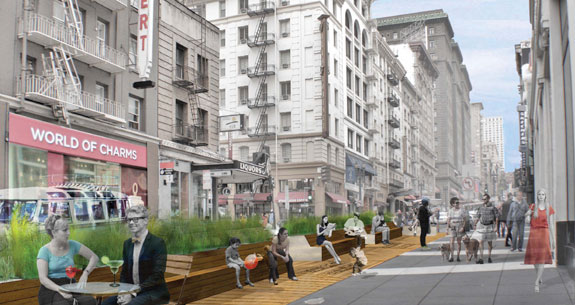Our friends at Streetsblog San Francisco offer some solid coverage of an offer Audi has made to the city: install two blocks of pedestrian amenities, including widened sidewalks and seating areas, on Powell Street between Ellis and Geary. We won’t duplicate what they wrote, but will note that beyond the pedestrian benefits, which could be considerable, this should make cable car operation in that area safer and more reliable.
With parked automobiles and trucks in the curb lane, running board riders take the risk of getting whacked by vehicle mirrors if they let it all hang out just a little too far. And motor vehicles pulling in and out of the parking spaces can cause significant delays.
 We’re assured that the design shown above is only conceptual; final decisions will be made locally. We hope so. The concept of the Otis Spunkmeyer lookalike drinking some kind of green Caribbean cocktail on Powell is a tad jarring. To add to the somewhat surreal scene, there’s no cable car in sight, but riding the tracks we can clearly discern — a vintage VW Microbus! Did Ken Kesey design this?
We’re assured that the design shown above is only conceptual; final decisions will be made locally. We hope so. The concept of the Otis Spunkmeyer lookalike drinking some kind of green Caribbean cocktail on Powell is a tad jarring. To add to the somewhat surreal scene, there’s no cable car in sight, but riding the tracks we can clearly discern — a vintage VW Microbus! Did Ken Kesey design this?
Seriously, if they actually intend to install benches like the ones “conceptually” shown, the people who actually occupy them probably won’t look like the folks in the drawing. Will the result be inviting to pedestrians, or will it turn into a gauntlet like you often find in the cable car passenger queue at Powell and Market?
Just asking.
With the right installation, though, this could be a huge plus for lower Powell Street, giving pedestrians much needed additional room to walk and clearing the way for at least a modest improvement in cable car service.
Best of all, if this temporary installation works, it can help pave the way for something permanent, perhaps modeled on the existing one-block cable car plaza between Market and Ellis.
The promenade is scheduled to be installed by April 2011. It is being managed by the Union Square Business Improvement District.
It is indeed an intersting idea, but I would hate to have it end up as an extension of the Cable Car Plaza between Market and Ellis. That dark stretch– as well as Hallidie Plaza– can’t really be pointed to as urban planning successes.
Let’s hope that this plan goes through and that the design makes this stretch friendlier to locals and tourists, pedestrians and cable cars alike.
We should have learned from various street conversions in the past, from 2nd Street in Santa Monica, to Fort Street in Honolulu, and of course, the abysmal Hallidie and Justin Herman Plazas: Urban streets are traffic arteries and veins, closing them off without careful thought can and almost always results in a situation worsened, not improved. In the case of Santa Monica, they went back and rethought the idea, allowing cars through on a reduced pavement, at certain hours and redesigned the pedestrian elements to encourage the urban aspect, to draw people in, and contribute to an active street scene, whereas the previous design had merely shut the street, added nothing worth seeing, and drove people away.
This preliminary design for lower Powell Street stinks, for all the reasons Rick listed, but we should still avoid the all too typical San Francisco response; “NO! ABSOLUTELY NOT!” and demand better concepts over which to give our consideration.
First off, the two blocks mentioned are transit blocks–the Cable Car turnaround is behind you, Union Square, most of the hotels and restaurants, and almost all the shopping is still ahead of you. Nothing about this design would deter a focused shopper, and little about it suggests it’d be a popular “rest the dogs” wayside on the way back to BART. On the other hand, if the restaurants were given space directly in front of their eateries and created al fresco menus suited to the setting (cocktails permitted)–and the climate–it might actually be quite the nice touch.